When modifying cookies, most people play around with sugar ratios, or upgrade their inclusions, subbing in chocolate discs for mere morsels. But you can go even deeper, down to the grain, and replace part or all of your all-purpose flour with something more flavorful.
Add complexity to chocolate cookies with rye flour
There’s nothing wrong with a Toll House chocolate chip cookie, or even the standard chocolate crinkle, but chocolate can veer towards cloying if you’re not careful. A good cookie doesn’t saturate your palate with sugar; balancing the sweetness gives them a more mature and refined flavor profile, and lets you eat more cookies before sugar fatigue sets in. The easiest way to bring balance to a chocolate-based confection? Rye flour.
Adding rye flour to baked goods is a trick we learned from Claire Ptak of Violet Cakes in London. Rye is a little bitter and a little savory, and makes the perfect counterpoint for the sugary high notes of a chocolate chip cookie. For our Rye Chocolate Chip Cookies, we toast the rye in a pan to give it some nutty complexity, then add some melted butter (and the rest of our wet ingredients), before mixing in an equal amount of all-purpose flour by mass. It’s a classic chocolate chip cookie, all grown up. (Watch Chris Kimball make a batch over on Instagram.)
Chocolate chip isn’t the only cookie that benefits from a bit of rye flour. It features heavily in Rose Wilde’s Rye Triple Chocolate Crinkle Cookies, where it lets you really pile on the chocolate by offering a slightly bitter counterbalance. Rose takes a grain-forward approach to baking, and these chocolate cookies are the better for it. They’re more interesting than the usual crinkle cookie, but look right at home on a holiday table, with a snowy-looking crispy shell and rich, fudgy center. You can learn to make these cookies—along with two others—during Holiday Cookie Fest, a hands-on class that will be taught by Rose on December 19 at Milk Street Cooking School.
For best results, we recommend using a finely ground rye flour, which absorbs liquid better than coarsely ground; look for one that has a powdery consistency similar to all-purpose flour. We prefer Arrowhead Mills Organic Rye, with Bob's Red Mill Dark Rye as a close second.

Make more interesting sugar cookies with corn flour
Speaking of Rose and her class, she’s got a sugar cookie that’s unlike any you’ve ever tasted. The standard sugar cookie is little more than a canvas for royal icing. It’s flat, sweet, and one-note—overall quite boring. Rose’s Corn Cookies with Candied Mango and Pink Peppercorn Sugar live at the opposite end of the cookie spectrum; they’re downright exciting. Again, Rose uses a whole grain flour to punch things up, in this case, corn flour. It gives the cookie a golden, cracked, crunchy exterior while intensifying its buttery notes. It’s beautiful as-is, like eating corn pudding with crispy edges, but Rose finishes these cookies with tangy candied dried mango and spicy pink peppercorn sugar.
There are many different types of ground corn products available at the grocery store, so pay attention to the label to ensure you get the right one. Cornstarch is not what you’re looking for. Though it’s sometimes referred to as “cornflour” by the British, it’s not flour at all, but pure, powdery starch extracted by washing slightly fermented portions of corn (the germ and endosperm). It’s a great thickening agent for gravy, but not what you want in these cookies.
When you look at a bag of corn flour, there should only be one ingredient: Whole-grain corn. It’s more finely ground than cornmeal, which will give your cookies a grittier texture. When in doubt, just look at it: Cornstarch will be fine and white, cornmeal with be coarse and yellow, and corn flour with be fine and yellow.
Masa harina is another form of ground corn you can use to perk up your holiday cookie tin, but it’s important to note that corn flour and masa harina are not interchangeable—the former is finely ground whole-grain corn; the latter is ground after undergoing a process called “nixtamalization,” where corn is soaked in an alkaline solution like calcium hydroxide or food-grade lye. This makes the grain’s nutrients more available, gives it a nutty, sweet aroma, and causes the kernels to swell. The nixtamalized corn, also known as “hominy,” is then washed, boiled, hulled, and ground. We use masa harina in our Corn and Cinnamon Butter Cookies, a shortbread-like cookie with subtle nutty notes and the sweet, warm fragrance of cinnamon.

Grind your own almond flour for better flavor
It’s no longer hard to source nut flours, but it’s also not hard to make them. That’s exactly what Great British Bake-Off semi-finalist Jürgen Krauss does when making his zimtsterne (cinnamon stars), a quick, rewarding, naturally gluten-free cookie that bakes up in half an hour. (Want to learn how to make these cookies from Jürgen himself? Sign up for his German Holiday Baking class on December 16.)
Grinding skin-on almonds gives the cookies a fresher, truer almond flavor, richer texture, and better color. Just grind them up using a high-powered blender or food processor, pulsing and scraping down the sides of the bowl as needed until you have a uniform, fine powder.
In addition to Jürgen’s cinnamon stars, you can use your homemade almond flour to make a batch of our Chocolate-Almond Spiced Cookies, a loose interpretation of the Swiss chocolate-almond holiday cookie known as Basler brunsli. Toast the almond flour to give it a deeper flavor, but make sure you it cool completely; hot almond meal will cook the egg whites, and you don’t want scrambled eggs in your cookie tin.
Photos: Rye Triple Chocolate Crinkle Cookies and Corn Cookies with Candied Mango and Pink Peppercorn Sugar, Rose Wilde; Chocolate Almond Spice Cookies, Jürgen Krauss
Join the conversation on Facebook, Instagram, TikTok and Pinterest.
And if you're looking for more Milk Street, check out our livestream cooking classes with our favorite chefs, home cooks and friends for global recipes, cooking methods and more.




